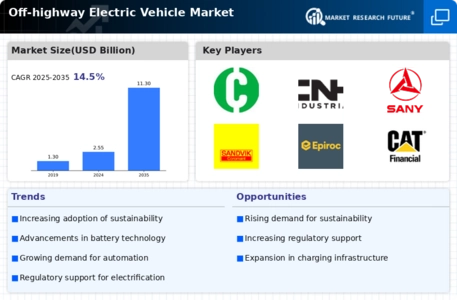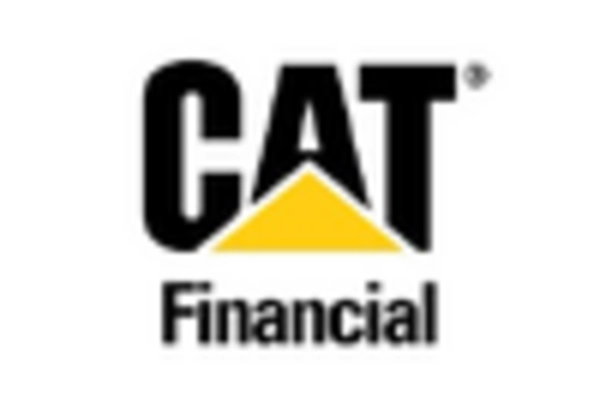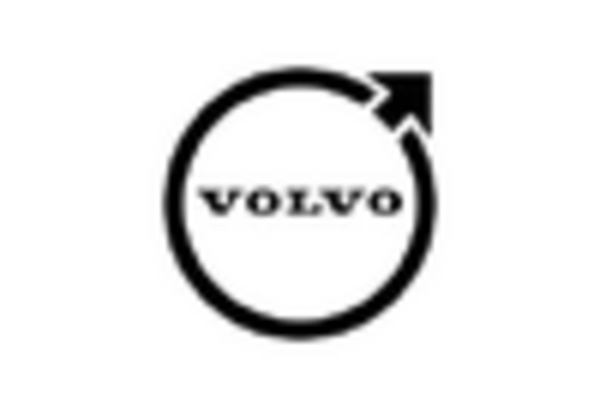-
EXECUTIVE SUMMARY
-
MARKET INTRODUCTION
-
Definition
-
Scope of the Study
- Research Objective
- Assumptions
- Limitations
-
RESEARCH METHODOLOGY
-
Overview
-
Data Mining
-
Secondary Research
-
Primary Research
- Primary Interviews
- Breakdown of Primary Respondents
-
and Information Gathering Process
-
Forecasting Modality
-
Market Size Estimation
- Bottom-Up Approach
- Top-Down Approach
-
Data Triangulation
-
Validation
-
MARKET DYNAMICS
-
Overview
-
Drivers
-
Restraints
-
Opportunities
-
MARKET FACTOR ANALYSIS
-
Value Chain Analysis
-
Porter’s Five Forces Analysis
- Bargaining Power
- Threat of New Entrants
- Threat of Substitutes
- Intensity of Rivalry
-
of Suppliers
-
5.2.2.
-
Bargaining Power of Buyers
-
COVID-19 Impact Analysis
- Market Impact Analysis
- Regional Impact
- Opportunity and
-
Threat Analysis
-
6.
-
GLOBAL OFF-HIGHWAY ELECTRIC VEHICLE MARKET, BY VEHICLE TYPE
-
Overview
-
HEV
-
BEV
-
GLOBAL OFF-HIGHWAY ELECTRIC VEHICLE MARKET, BY ENERGY STORAGE CAPACITY
-
Overview
-
7.2.
-
50–200 kWh
-
>200 kWh
-
GLOBAL OFF-HIGHWAY
-
ELECTRIC VEHICLE MARKET, BY BATTERY TYPE
-
Overview
-
Lithium-Ion (Li-Ion)
-
Lead–Acid
-
GLOBAL OFF-HIGHWAY ELECTRIC VEHICLE MARKET, BY
-
APPLICATION
-
9.1.
-
Overview
-
9.2.
-
Mining
-
9.3.
-
Construction
-
9.4.
-
Agriculture
-
9.5.
-
Others
-
10.
-
GLOBAL OFF-HIGHWAY ELECTRIC VEHICLE MARKET, BY REGION
-
Overview
-
North America
- U.S.
- Canada
-
Europe
- Germany
- France
- U.K
- Italy
- Spain
- Rest of Europe
-
Asia-Pacific
- China
- India
- Japan
- South Korea
- Australia
- Rest of Asia-Pacific
-
Rest of the World
- Middle East
- Africa
- Latin America
-
COMPETITIVE LANDSCAPE
-
Overview
-
Competitive Analysis
-
Market Share Analysis
-
Major Growth Strategy in the Global Off-highway
-
Electric Vehicle Market,
-
Competitive Benchmarking
-
Leading Players in Terms of Number of Developments
-
in the Global Off-highway Electric Vehicle Market,
-
Key developments and Growth Strategies
- New Vehicle Type
- Merger & Acquisitions
- Joint Ventures
-
Launch/Type Battery Type
-
Major Players Financial Matrix
- Sales & Operating
-
Income, 2022
-
11.8.2.
-
Major Players R&D Expenditure. 2022
-
COMPANY PROFILES
-
LIEBHERR-INTERNATIONAL DEUTSCHLAND GMBH
- Company Overview
- Financial Overview
- Vehicle Types
- Company Overview
- Financial Overview
- Vehicle Types Offered
- Key Developments
- SWOT Analysis
- Key Strategies
-
Offered
-
12.1.4.
-
Key Developments
-
12.1.5.
-
SWOT Analysis
-
12.1.6.
-
Key Strategies
-
12.2.
-
Cargotec corporation
-
12.2.1.
-
Company Overview
-
12.2.2.
-
Financial Overview
-
12.2.3.
-
Vehicle Types Offered
-
12.2.4.
-
Key Developments
-
12.2.5.
-
SWOT Analysis
-
12.2.6.
-
Key Strategies
-
12.3.
-
CLARK.
-
12.3.1.
-
Company Overview
-
12.3.2.
-
Financial Overview
-
12.3.3.
-
Vehicle Types Offered
-
12.3.4.
-
Key Developments
-
12.3.5.
-
SWOT Analysis
-
12.3.6.
-
Key Strategies
-
12.4.
-
CNH Industrial
-
12.4.1.
-
Company Overview
-
12.4.2.
-
Financial Overview
-
12.4.3.
-
Vehicle Types Offered
-
12.4.4.
-
Key Developments
-
12.4.5.
-
SWOT Analysis
-
12.4.6.
-
Key Strategies
-
12.5.
-
Narrow Isle inc..
-
12.5.1.
-
Company Overview
-
12.5.2.
-
Financial Overview
-
12.5.3.
-
Vehicle Types Offered
-
12.5.4.
-
Key Developments
-
12.5.5.
-
SWOT Analysis
-
12.5.6.
-
Key Strategies
-
12.6.
-
TOYOTA MOTOR CORPORATION.
-
SANY Group
- Company Overview
- Financial Overview
- Vehicle Types Offered
- Key Developments
- SWOT Analysis
- Key Strategies
-
Sandvik.
- Company Overview
- Financial Overview
- Vehicle Types Offered
- Key Developments
- SWOT Analysis
- Key Strategies
-
Epiroc.
- Company Overview
- Financial Overview
- Vehicle Types Offered
- Key Developments
- SWOT Analysis
- Key Strategies
-
Caterpillar
- Company Overview
- Financial Overview
- Vehicle Types Offered
- Key Developments
- SWOT Analysis
- Key Strategies
-
Komatsu Ltd..
- Company Overview
- Financial Overview
- Vehicle Types
- Company Overview
- Financial Overview
- Vehicle Types Offered
- Key Developments
- SWOT Analysis
- Key Strategies
-
Offered
-
12.11.4.
-
Key Developments
-
12.11.5.
-
SWOT Analysis
-
12.11.6.
-
Key Strategies
-
12.12.
-
Hitachi Construction Machinery.
-
DEERE & COMPANY.
- Company Overview
- Financial Overview
- Vehicle Types
- Company Overview
- Financial Overview
- Vehicle Types Offered
- Key Developments
- SWOT Analysis
- Key Strategies
-
Offered
-
12.13.4.
-
Key Developments
-
12.13.5.
-
SWOT Analysis
-
12.13.6.
-
Key Strategies
-
12.14.
-
JCB.
-
12.14.1.
-
Company Overview
-
12.14.2.
-
Financial Overview
-
12.14.3.
-
Vehicle Types Offered
-
12.14.4.
-
Key Developments
-
12.14.5.
-
SWOT Analysis
-
12.14.6.
-
Key Strategies
-
12.15.
-
AB Volvo.
-
12.15.1.
-
Company Overview
-
12.15.2.
-
Financial Overview
-
12.15.3.
-
Vehicle Types Offered
-
12.15.4.
-
Key Developments
-
12.15.5.
-
SWOT Analysis
-
12.15.6.
-
Key Strategies
-
12.16.
-
Anhui Heli Co., Ltd..
-
12.16.1.
-
Company Overview
-
12.16.2.
-
Financial Overview
-
12.16.3.
-
Vehicle Types Offered
-
12.16.4.
-
Key Developments
-
12.16.5.
-
SWOT Analysis
-
12.16.6.
-
Key Strategies
-
12.17.
-
Hyundai Doosan Infracore Co. Ltd.
-
APPENDIX
-
References
-
Related Reports
-
-
LIST OF TABLES
-
GLOBAL OFF-HIGHWAY ELECTRIC
-
VEHICLE MARKET, SYNOPSIS, 2018-2032
-
GLOBAL OFF-HIGHWAY ELECTRIC VEHICLE MARKET, ESTIMATES
-
& FORECAST, 2018-2032 (USD BILLION)
-
GLOBAL OFF-HIGHWAY ELECTRIC VEHICLE MARKET, BY VEHICLE
-
TYPE, 2018-2032 (USD BILLION)
-
GLOBAL OFF-HIGHWAY ELECTRIC VEHICLE MARKET, BY ENERGY STORAGE
-
CAPACITY, 2018-2032 (USD BILLION)
-
GLOBAL OFF-HIGHWAY ELECTRIC VEHICLE MARKET, BY BATTERY TYPE,
-
GLOBAL OFF-HIGHWAY ELECTRIC VEHICLE MARKET, BY APPLICATION,
-
NORTH AMERICA OFF-HIGHWAY ELECTRIC VEHICLE MARKET, BY VEHICLE
-
TYPE, 2018-2032 (USD BILLION)
-
NORTH AMERICA OFF-HIGHWAY ELECTRIC VEHICLE MARKET, BY ENERGY
-
STORAGE CAPACITY, 2018-2032 (USD BILLION)
-
NORTH AMERICA OFF-HIGHWAY ELECTRIC VEHICLE
-
MARKET, BY BATTERY TYPE, 2018-2032 (USD BILLION)
-
NORTH AMERICA OFF-HIGHWAY ELECTRIC VEHICLE
-
MARKET, BY APPLICATION, 2018-2032 (USD BILLION)
-
NORTH AMERICA OFF-HIGHWAY ELECTRIC VEHICLE
-
MARKET, BY COUNTRY, 2018-2032 (USD BILLION)
-
U.S. OFF-HIGHWAY ELECTRIC VEHICLE MARKET,
-
BY VEHICLE TYPE, 2018-2032 (USD BILLION)
-
U.S. OFF-HIGHWAY ELECTRIC VEHICLE MARKET, BY ENERGY
-
STORAGE CAPACITY, 2018-2032 (USD BILLION)
-
U.S. OFF-HIGHWAY ELECTRIC VEHICLE MARKET,
-
BY BATTERY TYPE, 2018-2032 (USD BILLION)
-
U.S. OFF-HIGHWAY ELECTRIC VEHICLE MARKET, BY APPLICATION,
-
CANADA OFF-HIGHWAY ELECTRIC VEHICLE MARKET, BY VEHICLE TYPE,
-
CANADA OFF-HIGHWAY ELECTRIC VEHICLE MARKET, BY ENERGY STORAGE
-
CAPACITY, 2018-2032 (USD BILLION)
-
CANADA OFF-HIGHWAY ELECTRIC VEHICLE MARKET, BY BATTERY TYPE,
-
CANADA OFF-HIGHWAY ELECTRIC VEHICLE MARKET, BY APPLICATION,
-
EUROPE OFF-HIGHWAY ELECTRIC VEHICLE MARKET, BY VEHICLE TYPE,
-
EUROPE OFF-HIGHWAY ELECTRIC VEHICLE MARKET, BY ENERGY STORAGE
-
CAPACITY, 2018-2032 (USD BILLION)
-
EUROPE OFF-HIGHWAY ELECTRIC VEHICLE MARKET, BY BATTERY TYPE,
-
EUROPE OFF-HIGHWAY ELECTRIC VEHICLE MARKET, BY APPLICATION,
-
EUROPE OFF-HIGHWAY ELECTRIC VEHICLE MARKET, BY COUNTRY, 2018-2032
-
(USD BILLION)
-
TABLE
-
GERMANY OFF-HIGHWAY ELECTRIC VEHICLE MARKET, BY VEHICLE TYPE, 2018-2032 (USD
-
BILLION)
-
TABLE
-
GERMANY OFF-HIGHWAY ELECTRIC VEHICLE MARKET, BY ENERGY STORAGE CAPACITY, 2018-2032
-
(USD BILLION)
-
TABLE
-
GERMANY OFF-HIGHWAY ELECTRIC VEHICLE MARKET, BY BATTERY TYPE, 2018-2032 (USD
-
BILLION)
-
TABLE
-
GERMANY OFF-HIGHWAY ELECTRIC VEHICLE MARKET, BY APPLICATION, 2018-2032 (USD BILLION)
-
FRANCE OFF-HIGHWAY
-
ELECTRIC VEHICLE MARKET, BY VEHICLE TYPE, 2018-2032 (USD BILLION)
-
FRANCE OFF-HIGHWAY ELECTRIC
-
VEHICLE MARKET, BY ENERGY STORAGE CAPACITY, 2018-2032 (USD BILLION)
-
FRANCE OFF-HIGHWAY ELECTRIC
-
VEHICLE MARKET, BY BATTERY TYPE, 2018-2032 (USD BILLION)
-
FRANCE OFF-HIGHWAY ELECTRIC VEHICLE MARKET,
-
BY APPLICATION, 2018-2032 (USD BILLION)
-
ITALY OFF-HIGHWAY ELECTRIC VEHICLE MARKET, BY VEHICLE
-
TYPE, 2018-2032 (USD BILLION)
-
ITALY OFF-HIGHWAY ELECTRIC VEHICLE MARKET, BY ENERGY STORAGE
-
CAPACITY, 2018-2032 (USD BILLION)
-
ITALY OFF-HIGHWAY ELECTRIC VEHICLE MARKET, BY BATTERY TYPE,
-
ITALY OFF-HIGHWAY ELECTRIC VEHICLE MARKET, BY APPLICATION,
-
SPAIN OFF-HIGHWAY ELECTRIC VEHICLE MARKET, BY VEHICLE TYPE,
-
SPAIN OFF-HIGHWAY ELECTRIC VEHICLE MARKET, BY ENERGY STORAGE
-
CAPACITY, 2018-2032 (USD BILLION)
-
SPAIN OFF-HIGHWAY ELECTRIC VEHICLE MARKET, BY BATTERY TYPE,
-
SPAIN OFF-HIGHWAY ELECTRIC VEHICLE MARKET, BY APPLICATION,
-
U.K OFF-HIGHWAY ELECTRIC VEHICLE MARKET, BY VEHICLE TYPE,
-
U.K OFF-HIGHWAY ELECTRIC VEHICLE MARKET, BY ENERGY STORAGE
-
CAPACITY, 2018-2032 (USD BILLION)
-
U.K OFF-HIGHWAY ELECTRIC VEHICLE MARKET, BY BATTERY TYPE,
-
U.K OFF-HIGHWAY ELECTRIC VEHICLE MARKET, BY APPLICATION, 2018-2032
-
(USD BILLION)
-
TABLE
-
REST OF EUROPE OFF-HIGHWAY ELECTRIC VEHICLE MARKET, BY VEHICLE TYPE, 2018-2032
-
(USD BILLION)
-
TABLE
-
REST OF EUROPE OFF-HIGHWAY ELECTRIC VEHICLE MARKET, BY ENERGY STORAGE CAPACITY,
-
REST OF EUROPE OFF-HIGHWAY ELECTRIC VEHICLE MARKET, BY BATTERY
-
TYPE, 2018-2032 (USD BILLION)
-
REST OF EUROPE OFF-HIGHWAY ELECTRIC VEHICLE MARKET, BY APPLICATION,
-
ASIA PACIFIC OFF-HIGHWAY ELECTRIC VEHICLE MARKET, BY VEHICLE
-
TYPE, 2018-2032 (USD BILLION)
-
ASIA PACIFIC OFF-HIGHWAY ELECTRIC VEHICLE MARKET, BY ENERGY
-
STORAGE CAPACITY, 2018-2032 (USD BILLION)
-
ASIA PACIFIC OFF-HIGHWAY ELECTRIC VEHICLE
-
MARKET, BY BATTERY TYPE, 2018-2032 (USD BILLION)
-
ASIA PACIFIC OFF-HIGHWAY ELECTRIC VEHICLE
-
MARKET, BY APPLICATION, 2018-2032 (USD BILLION)
-
ASIA PACIFIC OFF-HIGHWAY ELECTRIC VEHICLE
-
MARKET, BY COUNTRY, 2018-2032 (USD BILLION)
-
JAPAN OFF-HIGHWAY ELECTRIC VEHICLE MARKET,
-
BY VEHICLE TYPE, 2018-2032 (USD BILLION)
-
JAPAN OFF-HIGHWAY ELECTRIC VEHICLE MARKET, BY ENERGY
-
STORAGE CAPACITY, 2018-2032 (USD BILLION)
-
JAPAN OFF-HIGHWAY ELECTRIC VEHICLE MARKET,
-
BY BATTERY TYPE, 2018-2032 (USD BILLION)
-
JAPAN OFF-HIGHWAY ELECTRIC VEHICLE MARKET, BY APPLICATION,
-
CHINA OFF-HIGHWAY ELECTRIC VEHICLE MARKET, BY VEHICLE TYPE,
-
CHINA OFF-HIGHWAY ELECTRIC VEHICLE MARKET, BY ENERGY STORAGE
-
CAPACITY, 2018-2032 (USD BILLION)
-
CHINA OFF-HIGHWAY ELECTRIC VEHICLE MARKET, BY BATTERY TYPE,
-
CHINA OFF-HIGHWAY ELECTRIC VEHICLE MARKET, BY APPLICATION,
-
INDIA OFF-HIGHWAY ELECTRIC VEHICLE MARKET, BY VEHICLE TYPE,
-
INDIA OFF-HIGHWAY ELECTRIC VEHICLE MARKET, BY ENERGY STORAGE
-
CAPACITY, 2018-2032 (USD BILLION)
-
INDIA OFF-HIGHWAY ELECTRIC VEHICLE MARKET, BY BATTERY TYPE,
-
INDIA OFF-HIGHWAY ELECTRIC VEHICLE MARKET, BY APPLICATION,
-
AUSTRALIA OFF-HIGHWAY ELECTRIC VEHICLE MARKET, BY VEHICLE
-
TYPE, 2018-2032 (USD BILLION)
-
AUSTRALIA OFF-HIGHWAY ELECTRIC VEHICLE MARKET, BY ENERGY STORAGE
-
CAPACITY, 2018-2032 (USD BILLION)
-
AUSTRALIA OFF-HIGHWAY ELECTRIC VEHICLE MARKET, BY BATTERY
-
TYPE, 2018-2032 (USD BILLION)
-
AUSTRALIA OFF-HIGHWAY ELECTRIC VEHICLE MARKET, BY APPLICATION,
-
SOUTH KOREA OFF-HIGHWAY ELECTRIC VEHICLE MARKET, BY VEHICLE
-
TYPE, 2018-2032 (USD BILLION)
-
SOUTH KOREA OFF-HIGHWAY ELECTRIC VEHICLE MARKET, BY ENERGY
-
STORAGE CAPACITY, 2018-2032 (USD BILLION)
-
SOUTH KOREA OFF-HIGHWAY ELECTRIC VEHICLE
-
MARKET, BY BATTERY TYPE, 2018-2032 (USD BILLION)
-
SOUTH KOREA OFF-HIGHWAY ELECTRIC VEHICLE
-
MARKET, BY APPLICATION, 2018-2032 (USD BILLION)
-
REST OF ASIA-PACIFIC OFF-HIGHWAY ELECTRIC
-
VEHICLE MARKET, BY VEHICLE TYPE, 2018-2032 (USD BILLION)
-
REST OF ASIA-PACIFIC OFF-HIGHWAY ELECTRIC
-
VEHICLE MARKET, BY ENERGY STORAGE CAPACITY, 2018-2032 (USD BILLION)
-
REST OF ASIA-PACIFIC
-
OFF-HIGHWAY ELECTRIC VEHICLE MARKET, BY BATTERY TYPE, 2018-2032 (USD BILLION)
-
REST OF ASIA-PACIFIC
-
OFF-HIGHWAY ELECTRIC VEHICLE MARKET, BY APPLICATION, 2018-2032 (USD BILLION)
-
REST OF WORLD
-
OFF-HIGHWAY ELECTRIC VEHICLE MARKET, BY VEHICLE TYPE, 2018-2032 (USD BILLION)
-
REST OF WORLD
-
OFF-HIGHWAY ELECTRIC VEHICLE MARKET, BY ENERGY STORAGE CAPACITY, 2018-2032 (USD
-
BILLION)
-
TABLE
-
REST OF WORLD OFF-HIGHWAY ELECTRIC VEHICLE MARKET, BY BATTERY TYPE, 2018-2032
-
(USD BILLION)
-
TABLE
-
REST OF WORLD OFF-HIGHWAY ELECTRIC VEHICLE MARKET, BY APPLICATION, 2018-2032
-
(USD BILLION)
-
TABLE
-
REST OF WORLD OFF-HIGHWAY ELECTRIC VEHICLE MARKET, BY COUNTRY, 2018-2032 (USD
-
BILLION)
-
TABLE
-
MIDDLE EAST OFF-HIGHWAY ELECTRIC VEHICLE MARKET, BY VEHICLE TYPE, 2018-2032 (USD
-
BILLION)
-
TABLE
-
MIDDLE EAST OFF-HIGHWAY ELECTRIC VEHICLE MARKET, BY ENERGY STORAGE CAPACITY,
-
MIDDLE EAST OFF-HIGHWAY ELECTRIC VEHICLE MARKET, BY BATTERY
-
TYPE, 2018-2032 (USD BILLION)
-
MIDDLE EAST OFF-HIGHWAY ELECTRIC VEHICLE MARKET, BY APPLICATION,
-
AFRICA OFF-HIGHWAY ELECTRIC VEHICLE MARKET, BY VEHICLE TYPE,
-
AFRICA OFF-HIGHWAY ELECTRIC VEHICLE MARKET, BY ENERGY STORAGE
-
CAPACITY, 2018-2032 (USD BILLION)
-
AFRICA OFF-HIGHWAY ELECTRIC VEHICLE MARKET, BY BATTERY TYPE,
-
AFRICA OFF-HIGHWAY ELECTRIC VEHICLE MARKET, BY APPLICATION,
-
LATIN AMERICA OFF-HIGHWAY ELECTRIC VEHICLE MARKET, BY VEHICLE
-
TYPE, 2018-2032 (USD BILLION)
-
LATIN AMERICA OFF-HIGHWAY ELECTRIC VEHICLE MARKET, BY ENERGY
-
STORAGE CAPACITY, 2018-2032 (USD BILLION)
-
LATIN AMERICA OFF-HIGHWAY ELECTRIC VEHICLE
-
MARKET, BY BATTERY TYPE, 2018-2032 (USD BILLION)
-
LATIN AMERICA OFF-HIGHWAY ELECTRIC VEHICLE
-
MARKET, BY APPLICATION, 2018-2032 (USD BILLION)
-
-
LIST OF FIGURES
-
RESEARCH PROCESS
-
MARKET STRUCTURE FOR THE GLOBAL OFF-HIGHWAY
-
ELECTRIC VEHICLE MARKET
-
MARKET DYNAMICS FOR THE GLOBAL OFF-HIGHWAY ELECTRIC VEHICLE
-
MARKET
-
FIGURE
-
GLOBAL OFF-HIGHWAY ELECTRIC VEHICLE MARKET, SHARE (%), BY VEHICLE TYPE, 2022
-
GLOBAL OFF-HIGHWAY
-
ELECTRIC VEHICLE MARKET, SHARE (%), BY ENERGY STORAGE CAPACITY, 2022
-
GLOBAL OFF-HIGHWAY ELECTRIC
-
VEHICLE MARKET, SHARE (%), BY BATTERY TYPE, 2022
-
GLOBAL OFF-HIGHWAY ELECTRIC VEHICLE MARKET,
-
SHARE (%), BY APPLICATION, 2022
-
GLOBAL OFF-HIGHWAY ELECTRIC VEHICLE MARKET, SHARE (%), BY
-
REGION, 2022
-
FIGURE
-
NORTH AMERICA: OFF-HIGHWAY ELECTRIC VEHICLE MARKET, SHARE (%), BY REGION, 2022
-
EUROPE: OFF-HIGHWAY
-
ELECTRIC VEHICLE MARKET, SHARE (%), BY REGION, 2022
-
ASIA-PACIFIC: OFF-HIGHWAY ELECTRIC VEHICLE
-
MARKET, SHARE (%), BY REGION, 2022
-
REST OF THE WORLD: OFF-HIGHWAY ELECTRIC VEHICLE
-
MARKET, SHARE (%), BY REGION, 2022
-
GLOBAL OFF-HIGHWAY ELECTRIC VEHICLE MARKET: COMPANY
-
SHARE ANALYSIS, 2022 (%)
-
LIEBHERR-INTERNATIONAL DEUTSCHLAND GMBH: FINANCIAL OVERVIEW
-
SNAPSHOT
-
FIGURE
-
LIEBHERR-INTERNATIONAL DEUTSCHLAND GMBH: SWOT ANALYSIS
-
CARGOTEC CORPORATION: FINANCIAL OVERVIEW
-
SNAPSHOT
-
FIGURE
-
CARGOTEC CORPORATION: SWOT ANALYSIS
-
CLARK.: FINANCIAL OVERVIEW SNAPSHOT
-
CLARK.: SWOT
-
ANALYSIS
-
FIGURE
-
CNH INDUSTRIAL: FINANCIAL OVERVIEW SNAPSHOT
-
CNH INDUSTRIAL: SWOT ANALYSIS
-
NARROW ISLE
-
INC...: FINANCIAL OVERVIEW SNAPSHOT
-
NARROW ISLE INC...: SWOT ANALYSIS
-
TOYOTA MOTOR CORPORATION.:
-
FINANCIAL OVERVIEW SNAPSHOT
-
TOYOTA MOTOR CORPORATION.: SWOT ANALYSIS
-
SANY GROUP: FINANCIAL
-
OVERVIEW SNAPSHOT
-
FIGURE
-
SANY GROUP: SWOT ANALYSIS
-
SANDVIK.: FINANCIAL OVERVIEW SNAPSHOT
-
SANDVIK.: SWOT ANALYSIS
-
EPIROC.: FINANCIAL
-
OVERVIEW SNAPSHOT
-
FIGURE
-
EPIROC.: SWOT ANALYSIS
-
CATERPILLAR.: FINANCIAL OVERVIEW SNAPSHOT
-
CATERPILLAR.: SWOT
-
ANALYSIS
-
FIGURE
-
KOMATSU LTD.: FINANCIAL OVERVIEW SNAPSHOT
-
KOMATSU LTD.: SWOT ANALYSIS
-
HITACHI CONSTRUCTION
-
MACHINERY.: FINANCIAL OVERVIEW SNAPSHOT
-
HITACHI CONSTRUCTION MACHINERY.: SWOT ANALYSIS
-
FIGURE 38
-
DEERE & COMPANY.: FINANCIAL OVERVIEW SNAPSHOT
-
DEERE & COMPANY.: SWOT ANALYSIS
-
JCB.: FINANCIAL
-
OVERVIEW SNAPSHOT
-
FIGURE
-
JCB.: SWOT ANALYSIS
-
AB VOLVO.: FINANCIAL OVERVIEW SNAPSHOT
-
AB VOLVO.: SWOT ANALYSIS
-
FIGURE 44
-
ANHUI HELI CO., LTD..: FINANCIAL OVERVIEW SNAPSHOT
-
ANHUI HELI CO., LTD..: SWOT ANALYSIS
-
HYUNDAI DOOSAN
-
INFRACORE CO. LTD...: FINANCIAL OVERVIEW SNAPSHOT
-
HYUNDAI DOOSAN INFRACORE CO. LTD...: SWOT
-
ANALYSIS









Leave a Comment